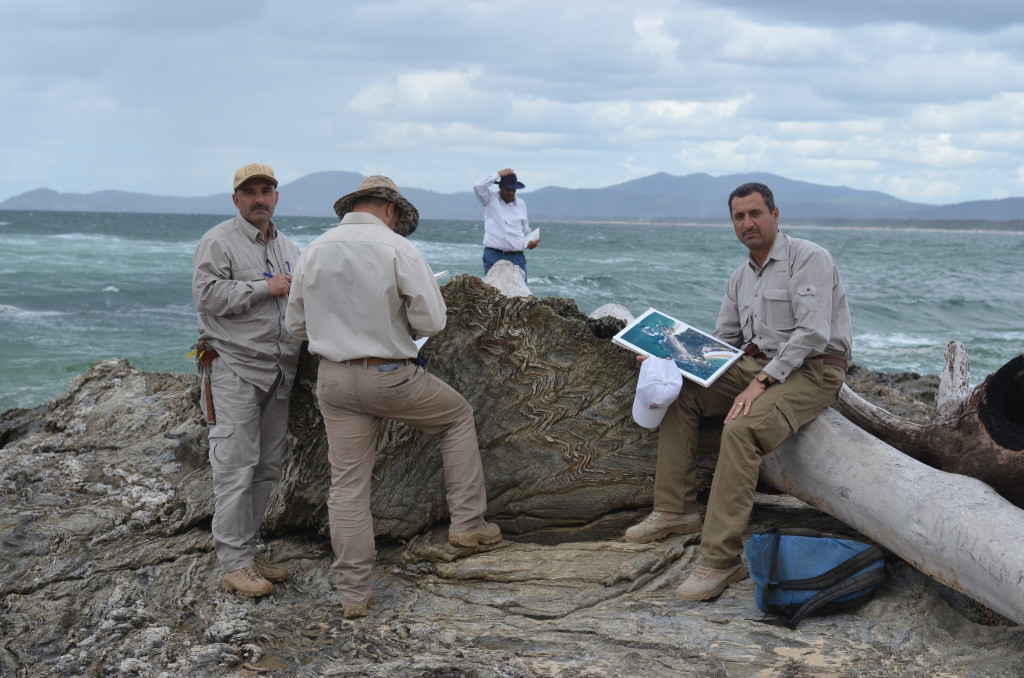Impressive rock exposures and magnificent landscape in your study area are nice but having them reveal unique regional tectonic events is exciting and worth working hard for (Fig. 1).

Figure 1: Geologists from the Iraqi Geological Survey, in a structural mapping course at the multi-deformed rocks of Nambucca Heads, New South Wales, Australia.
The easternmost part of the Australian continent consists of a Late Palaeozoic to Early Mesozoic orogenic belt that is tightly curved into an omega shaped oroclinal structure (Fig. 2). My PhD work, under the supervision of A/Prof Gideon Rosenbaum, at the University of Queensland, Australia, is focused on understanding the formation mechanism and geodynamic processes that led to the development of this oroclinal structure (hereinafter the New England oroclines). The fingerprints of the oroclinal structure are marked in Early Permian and older rocks, predominantly in Devonian-Carboniferous subduction related tectono-stratigraphic units. Understanding this oroclinal structure is not trivial as the structure is of continental scale, and rock exposures are discontinuous, disrupted and/or concealed by younger rocks and deformation events.
At the centre of this oroclinal structure, a thick sedimentary succession referred to as the Nambucca Block records multi-phase deformation that was likely developed during the formation of the New England oroclines. The terrain is rugged and lush (e.g., Fig. 3) and the best outcrops are found in coastal headlands (Fig. 4). I have spent 20 days of mapping in deserted coasts, and have constantly resisted the temptation of swimming and relaxing in the azure-coloured water of the South Pacific Ocean! The dedication was proven to pay off. We managed to define four distinct deformation phases and correlate microscopic (Fig. 1) and mesoscopic (Fig. 5) structures. The structural mapping provided kinematic constraints on the development of the oroclinal structure (see Shaanan et al., 2014, Tectonics), but at that stage of my research, the driving mechanism has remained unknown.

Figure 3: A/Prof Gideon Rosenbaum and PhD student Uri Shaanan in the rugged lush terrain of the Nambucca Block.
Further research on the age and provenance of the sediments in the Nambucca Block led to the discovery of surprising and exciting results! We found that a large fraction of the detritus in the succession is Precambrian, which means that the sedimentary rocks of the Nambucca Block, which were deposited in the Early Permian on top of earlier (Devonian-Carboniferous) fore-arc units, received additional continental detritus. During the Early Permian, eastern Australia was subjected to extension, so the input of continental detritus led us to conclude that the sedimentary rocks of the Nambucca Block must have been deposited in a back-arc basin. In other words, the area that was a fore-arc region during the Carboniferous became a back-arc region in the Early Permian. This implies a significant migration of the paleo-Pacific plate boundary. The contemporaneous formation of the New England oroclines suggests that, similarly to modern examples such as in the Mediterranean, subduction rollback was the main driving mechanism that controlled oroclinal bending in Palaeozoic eastern Australia (see Shaanan et al., 2015, GSA Bulletin).
To complete my research on the New England oroclines, I have conducted additional paleomagnetic and paleogeographic investigations. The paleomagnetic work yielded constraints on the timing of oroclinal bending. Additional geochronological provenance investigation and regional correlation of Early Permian successions within the oroclinal structure provided new insights into the Early Permian palaeogeography of the southern New England Orogen further supporting our proposed geodynamic model for the formation of the New England Oroclines. Both the paleomagnetic and the paleogeographic projects are in production stages for publication.
![]() This work is licensed under a Creative Commons Attribution-NonCommercial-ShareAlike 4.0 International License.
This work is licensed under a Creative Commons Attribution-NonCommercial-ShareAlike 4.0 International License.



